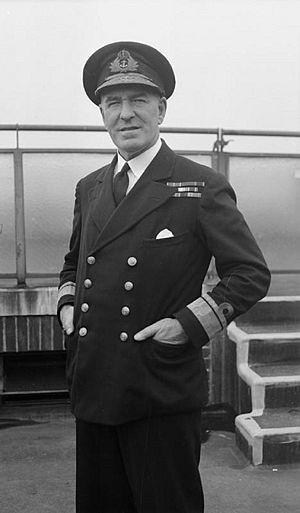Harold Burrough facts for kids
Quick facts for kids
Sir Harold Burrough
|
|
|---|---|
 |
|
| Born | 4 July 1889 |
| Died | 22 October 1977 |
| Allegiance | |
| Service/ |
|
| Years of service | 1903 - 1949 |
| Rank | Admiral |
| Commands held | HMS London Nore Command |
| Battles/wars | World War I World War II |
| Awards | Knight Grand Cross of the Order of the Bath Knight Commander of the Order of the British Empire Distinguished Service Order |
Sir Harold Martin Burrough was a brave and important officer in the Royal Navy. He was born on July 4, 1889, and passed away on October 22, 1977. During World War II, he played a key role as an Admiral and helped lead the Navy's operations.
Contents
Harold Burrough began his exciting career in the Navy in 1903. He first joined as a naval cadet, which is like a student learning to become an officer. He had gone to school at St Edward's School, Oxford before this.
His first experience in battle was during World War I. He served as an officer in charge of guns on a ship called HMS Southampton. He even took part in a very big naval battle called the Battle of Jutland in 1916.
As he gained more experience, he was given command of his own ship, HMS London, in 1930. Later, he led a group of destroyer ships and then became the head of HMS Excellent, which was a special training school for naval gunnery. By 1939, he was promoted to a senior position, helping to plan naval strategies.
Leading in World War II
When World War II began, Admiral Burrough took on even bigger responsibilities. In September 1940, he was put in charge of the 10th Cruiser Squadron, a group of powerful warships.
One of his notable achievements was during Operation Archery in December 1941. This was a daring raid on some Norwegian islands called Vågsøy and Måløy. Under his command, the Navy and Royal Air Force worked together to sink nine enemy ships. The raiding force also defeated the enemy soldiers on the islands. For his bravery and leadership in this operation, he received a special award called the DSO.
Admiral Burrough continued to serve on the Naval Staff, helping to plan important missions. In July 1942, he led the ships that protected a vital convoy during Operation Pedestal. This mission was crucial for getting supplies to the island of Malta. Soon after, he directed the Allied naval forces during Operation Torch, which involved landing troops in Algiers and other parts of Northwest Africa.
Final Years of the War and Beyond
In 1943, Admiral Burrough became the top naval officer in Gibraltar and the Mediterranean Sea. He then took over as the Allied Naval Commander-in-Chief for the Expeditionary Force in January 1945. This meant he was in charge of planning all the naval strategies and operations for the Allies. He worked very closely with U.S. General Dwight D. Eisenhower during the final stages of the war.
Admiral Burrough was one of the important people who signed the German Surrender Documents on May 7, 1945, in Rheims, France. This officially ended the war in Europe.
After the war, he stayed in Germany as the naval commander. One of his important jobs was to help create the German Mine Sweeping Administration, which cleared dangerous mines from the seas. In 1946, he became the Commander-in-Chief of The Nore, a major naval command in the UK.
Admiral Burrough retired from the Navy in 1949. He was given a very high honor, becoming a Knight Grand Cross of the Order of the Bath (GCB). He passed away on October 22, 1977.
Family Life
Admiral Burrough was married to Nellie Wills in 1914. They had two sons and three daughters together. His wife passed away in 1972.

